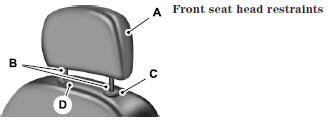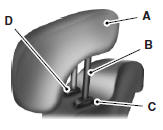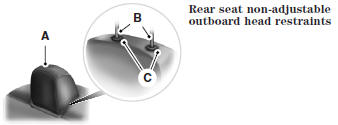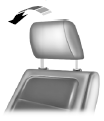WARNING:
To minimize the risk of neck injury in the event of a crash, the driver and passenger occupants should not sit in or operate the vehicle, until the head restraint is placed in its proper position. The driver should never adjust the head restraint while the vehicle is in motion.
WARNING:
The adjustable head restraint is a safety device.
Whenever possible it should be installed and properly adjusted when the seat is occupied.
WARNING:
Install the head restraint properly to minimize the risk of neck injury in the event of a crash.
Note
: Before adjusting any head restraint, adjust the seat back to an upright driving or riding position. Properly adjust the head restraint so that the top of the head restraint is even with the top of your head and positioned as close as possible to the back of your head. For occupants of extremely tall stature, adjust the head restraint to its full up position.
To adjust the head restraint, do the following:


Rear seat center head restraint
The head restraints consist of: A. An energy absorbing head restraint
B. Two steel stems
C. Guide sleeve adjust and release button
D. Guide sleeve unlock and remove button
• Raise: Pull up on the head restraint (A).
• Lower: Press and hold the guide sleeve adjust and release button (C) and push down on the head restraint (A).
• Remove: Pull up the head restraint until it reaches the highest adjustment position and then press and hold both the adjust and release button (C) and the unlock and remove button (D), then pull up on the head restraint.
• Reinstall: Align the steel stems into the guide sleeves and push the head restraint down until it locks.

The head restraints consist of: A. An energy absorbing head restraint
B. Two steel stems
C. Guide sleeve unlock and remove button
• Remove: Simultaneously press and hold both unlock and remove buttons (C), then pull up on the head restraint.
• Reinstall: Align the steel stems into the guide sleeves and push the head restraint down until it locks.
Tilting Head Restraints (If Equipped)
The front head restraints may tilt for extra comfort. To tilt the head restraint, do the following:

1. Adjust the seatback to an upright driving or riding position.
2. Tilt the head restraint forward by gently pulling the top of the head restraint.
Once it is in its forward-most position, tilt it forward once more to release it to the upright position.
Note: Do not attempt to force the head restraint backward after it is tilted. Instead, continue tilting it forward until the head restraint releases to the upright position.
 Sitting in the correct position
Sitting in the correct position
WARNING: Sitting improperly out of position or with the seat
back reclined too far can take off weight from the seat cushion
and affect the decision of the passenger sensing system, resulting in
se ...
 Front manual seats
Front manual seats
WARNING: Do not adjust the driver’s seat or seatback while the
vehicle is moving.
WARNING: Rock the seat backward and forward after releasing
the lever to make sure that it is fully engaged.
M ...
Other materials:
Disassembly and Assembly of Subassemblies
Cylinder Head
Special Tool(s)
Material
Cylinder Head
NOTE: RH shown, LH similar.
Disassembly
NOTE: If the components are to be reinstalled, they must be installed
in the same positions. Mark the components for installation into their original
locations.
Using the Valve Spring Comp ...
Module Communications Network
DESCRIPTION AND OPERATION
Communications Network
Overview
Multiplexing is a method of sending 2 or more signals simultaneously on the
same network circuits. Multiplexing is used to allow 2 or more electronic
modules (nodes) to communicate simultaneously over a twisted-wire pair [data (+)
and data ...
Four Wheel Drive (4WD) Systems
DESCRIPTION AND OPERATION
All Wheel Drive (AWD) Systems
The AWD system consists of the following:
PTU
Rear driveshaft
AWD relay module
Rear axle with ATC solenoid
Torque from the engine is transferred through the transmission to the PTU.
This torque is transferre ...
